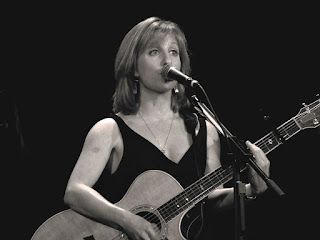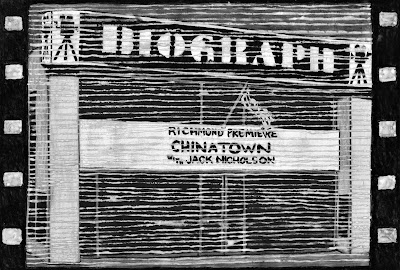Carole Kass Remembrance
During
my nearly 12-year stint as the manager of the Biograph Theatre
(1972-83) I spoke with Carole nearly every week, sometimes more than
once. She came to the theater regularly to review first-run pictures.
She came to see movies she liked on her own time. Plus she was there
for various social occasions and a publicity stunt, or two.
In
the process, over the years, we got to be friends and learned to
trust one another. The genuine enthusiasm and warmth Carole brought
to her work as a movie critic/entertainment columnist was uncommon.
Those same traits were seen in other things she touched. Whether she
was helping out a little independent movie theater with her words in
ink, or teaching cinema history to undergraduates at Virginia
Commonwealth University, or teaching film production to inmates at
the Virginia State Penitentiary, Carole always cared and it showed.
Carole understood the power motion pictures have to lift people from the grips of their melancholia and pesky vexations, if only for a few sweet moments.
My last show-biz encounter with Carole took place in 1998, when she was part of the Jewish Community Center’s presentation of a live Joan Rivers show at the then-Carpenter Center. My job, as a freelance videographer, was to record the performance for the sponsors with two cameras; one for closeups and the other for a static wide shot of the stage.
Rivers’ topic was surviving tragedy; in spite of the subject she was quite funny. After her prepared remarks, Joan answered questions submitted by members of the audience and then asked of her onstage by Carole. Their impromptu performance together was nearly as good as what had gone before.
At that time, it was public knowledge that Carole was battling cancer. She joked with me that night about her fretting over whether she would live long enough to do the show for the JCC. A few days after that performance I went out to her home in the West End for a visit. I wanted to shoot some stills of old photographs of her to insert into the video, to play over the sound of her introduction in the show. And, I was still searching for a way to tell her how much she had always meant to the Biograph’s survival and to the film-loving community in Richmond.
Typically, Carole was her modest self. In her view, she had only been a background artist, helping out. Then there had been the retirement Media General had imposed on her a few years before, which had never set all that well with Carole.
A week or so later, I delivered a video tape to her. It included Rivers’ talk to the audience and what followed. At the end of the tape there was a tribute to Carole that I had staged, shot and edited without her knowledge; I didn’t let on about the surprise.
Here’s what Carole didn’t know as she began watching the tape: The R-TD’s then-executive editor, Bill Millsaps, had helped me out with a stunt by asking all the writers to come outside for about 20 minutes to be the performers in a tribute to Carole. Others from the local film buff community, including former staff members at the Biograph, were also asked to be on hand.
The cast was directed to walk around for a while, then stand applauding in front of 333 W. Grace St., an entrance to the newspaper’s building that no longer exists. I had help shooting the scene from Jerry Williams and Ted Salins, who manned two of three cameras I used.
Later I edited the footage from the three tapes into a short piece, using music from the movie “8½” for sound; the imagery also imitated it, somewhat. That particular Fellini flick was one of her favorites. No one had told Carole a word about it; it had been beautiful teamwork.
When she saw the added tribute footage, watching it with pain as her only companion, Carole couldn’t fathom that all those people had actually been assembled, just to give her a standing ovation. When she called, she told me she had assumed I found the footage, somewhere, and spliced it onto end of the tape. Where had I found it? she asked.
With a measure of satisfaction I chuckled and informed her how the scene was actually set up. She didn’t buy it! Carole thanked me warmly, but added a gentle scolding for my trying to fool her about the mysterious scene, shot in front of the old entrance to 333. She reminded me of my reputation as a trickster. Not wanting to argue with her, I let it go.
Later Carole telephoned then-television critic Douglas Durden, only to hear from her old friend (they sat at desks next to one another for years) that it all had been just as I said.
After talking with others at the newspaper, Carole called me back to laugh, to cry and to apologize for not believing me. She went on to say that what had started out as a rather “bad day” for her — coping with the indignities of her situation — had been changed into a “good day.”
As my mother died of cancer in 1984, I could grasp what Carole might have meant by “good days” and “bad days.” Carole thanked me for that good day. I told her I’d had a lot of help. Click here to read the obituary I wrote for Carole Kass in 2000.
Twelve years ago it began with an idea for a gesture to lift an old friend’s spirits and let her know how much her colleagues and the rest of us appreciated her. The finished product, with Carole’s double-take reaction actually turned out better than I had envisioned.
Back in the summer of 1998, I gave a print of the tape to Saps, to say, “Thanks.” Naturally, the JCC got a tape. Note: what is shown in the YouTube video linked to above is just the 90-minute tape’s last two minutes and 39 seconds. (Sorry about the low quality of the transfer from video to digital; one day I'll have the entire tape transferred properly.)
And, dear reader, a good day is wished to you and yours.


Comments
Post a Comment